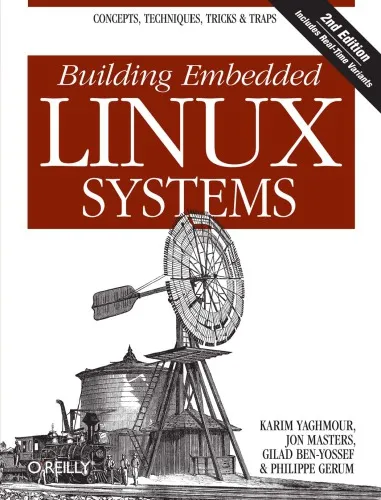Building embedded Linux systems : Previous ed.: published as by Karim Yaghmour. 2003. - Includes index
4.5
Reviews from our users

You Can Ask your questions from this book's AI after Login
Each download or ask from book AI costs 2 points. To earn more free points, please visit the Points Guide Page and complete some valuable actions.Welcome to Building Embedded Linux Systems, a comprehensive guide for developers, engineers, and hobbyists looking to master the intricacies of creating robust embedded systems using Linux. Written by Karim Yaghmour and co-authored by subject-matter experts, this book establishes itself as an essential resource for anyone venturing into the dynamic domain of embedded systems design. With a history rooted in cutting-edge technology and practical implementations, it’s a must-read for professionals wanting to seamlessly integrate Linux into their embedded applications.
Detailed Summary of the Book
Building Embedded Linux Systems explores the end-to-end process of constructing powerful embedded systems based on Linux. Starting with an introduction to embedded systems and their significance in modern technology, the book dives deep into the Linux kernel, bootloaders, filesystems, and user spaces tailored for embedded devices.
The authors meticulously break down complex topics, providing step-by-step instructions on customization and fine-tuning every aspect of the system. Covering everything from cross-compilation toolchains to debugging and profiling applications, this book ensures that readers not only understand how embedded Linux works but also gain the practical skills needed to implement solutions.
Furthermore, the book delves into real-world examples that showcase its concepts in action. It emphasizes scalability, optimization, and modularity, which are critical for embedded applications across industries ranging from automotive to IoT.
Key Takeaways
- Understand the architecture and components of embedded Linux systems.
- Learn how to configure and build customized Linux kernels for specific hardware platforms.
- Master the use of bootloaders like U-Boot and understand their role in launching embedded systems.
- Gain insights on creating efficient root filesystems catering to resource-constrained devices.
- Discover advanced topics such as device drivers, debugging techniques, and performance optimization.
- Explore open-source tools that simplify embedded systems development.
- Apply embedded Linux knowledge to real-world use cases like industrial automation, consumer electronics, and IoT devices.
Famous Quotes from the Book
"Linux gives you the flexibility and openness needed to craft embedded systems tailored to any challenge, without reinventing the wheel."
"The true power of embedded systems lies in leveraging the robustness of Linux alongside your hardware's capabilities."
"Every embedded project is a journey into the intersection of low-level hardware and high-level software. Success lies in mastering both worlds."
Why This Book Matters
In the era of pervasive computing, embedded systems play a quintessential role in driving technological innovation. From smart appliances to autonomous vehicles, embedded Linux systems are at the forefront of this evolution. Building Embedded Linux Systems empowers readers with the expertise to design, build, and optimize embedded solutions that leverage the versatility and stability of Linux.
What makes this book stand out is its unique blend of theoretical depth and practical application. It doesn't merely present concepts—it equips readers with actionable knowledge that can be applied directly to their projects. Developers gain insights that help them address challenges like security, scalability, and resource constraints with confidence.
Whether you're an experienced engineer or a curious enthusiast, this book bridges the gap between complex technical details and real-world implementation, earning its place as an invaluable resource for embedded system creators. Beyond just being a technical reference, it fosters an appreciation for the collaborative, open-source community that drives Linux forward—a sentiment echoed throughout its pages.
Free Direct Download
Get Free Access to Download this and other Thousands of Books (Join Now)
For read this book you need PDF Reader Software like Foxit Reader
Accessing books through legal platforms and public libraries not only supports the rights of authors and publishers but also contributes to the sustainability of reading culture. Before downloading, please take a moment to consider these options.
Find this book on other platforms:
WorldCat helps you find books in libraries worldwide.
See ratings, reviews, and discussions on Goodreads.
Find and buy rare or used books on AbeBooks.


